Red Osier Dogwood Quick Growth Guide
Photo:
Red Osier Dogwood Fruit and Leaves by Krzysztof Golik, CC BY-SA 4.0, via Wikimedia Commons
Red Osier Dogwood has unique red stems that look great in all seasons. It is simple to grow and grows quickly. It has white flowers in the early spring and white to pale blue fruit in the late summer.
Cornus stolonifera natural habitat: Shores, river flats, edges of marshes, damp open woods and thickets. It can grow up to 8 feet (260 cms) in height, but there is dwarf version which grows to 4 feet (130 cms).
Quick Growing Guide
Botanical Name: Cornus stolonifera
En français: Cornouiller stolonifère
Blooms:
Sun / Shade:
Water: Requires plenty of water.
Soil:
Height:
Width:
Care:

This Dogwood is easily transplanted. Flat-topped Red stems look wonderful in winter garden. Needs rejuvenation pruning to maintain red stems and longer life. Lower branches prostrate and may root. Best in informal, natural settings. Will grow on a variety of poorly drained soils or sand in pH 5.0 – 6.5.







Leave a Reply
You must be logged in to post a comment.